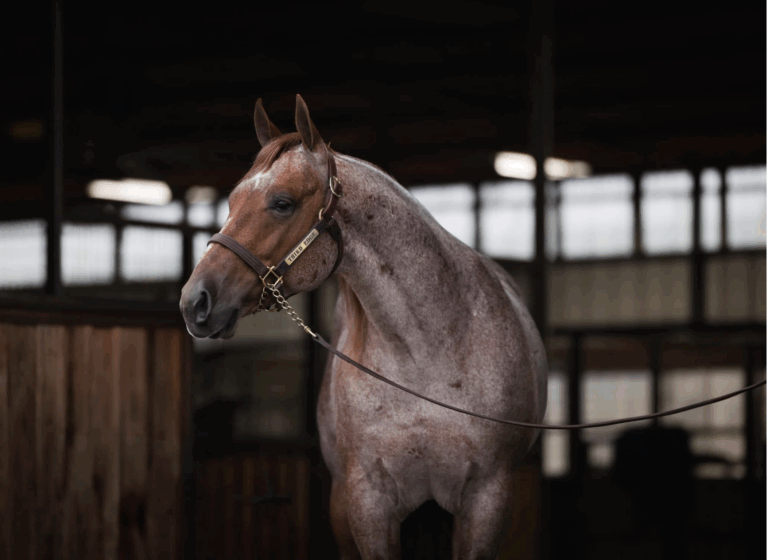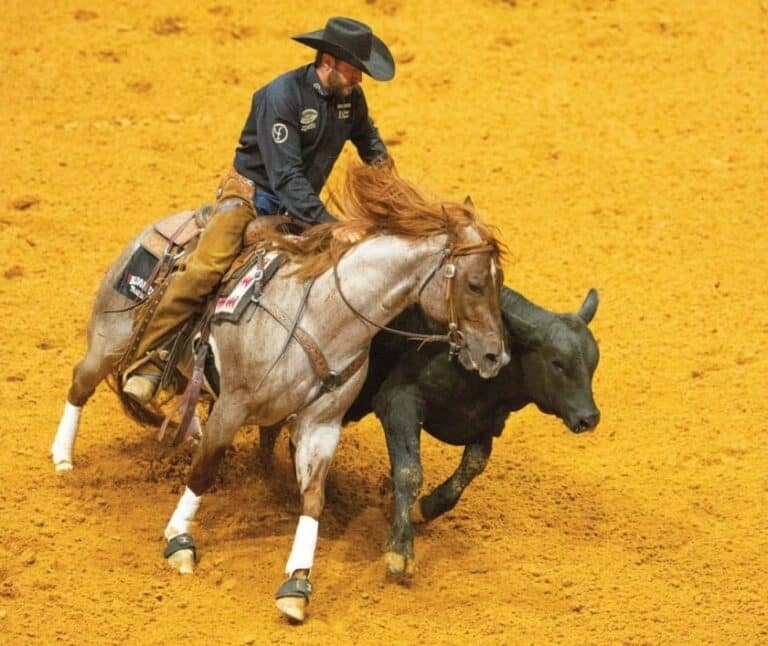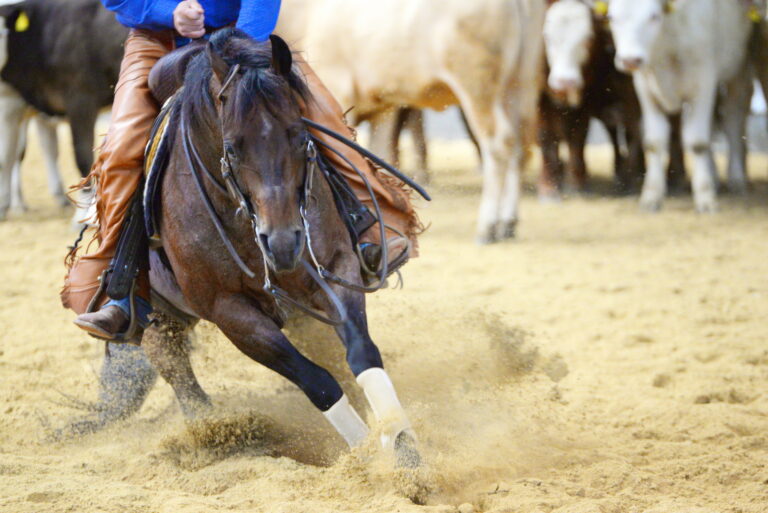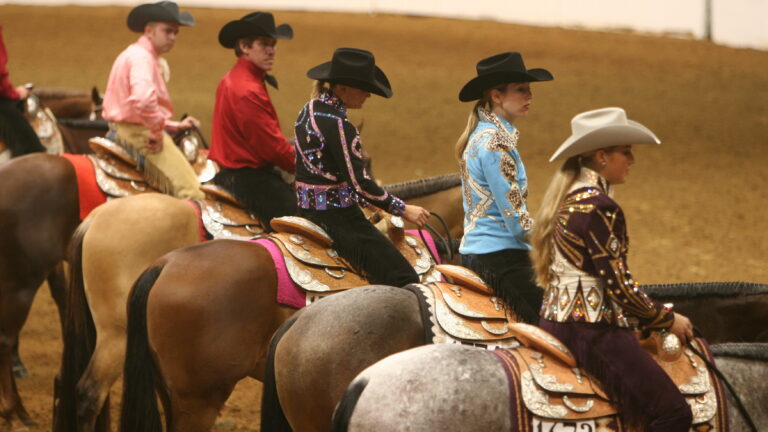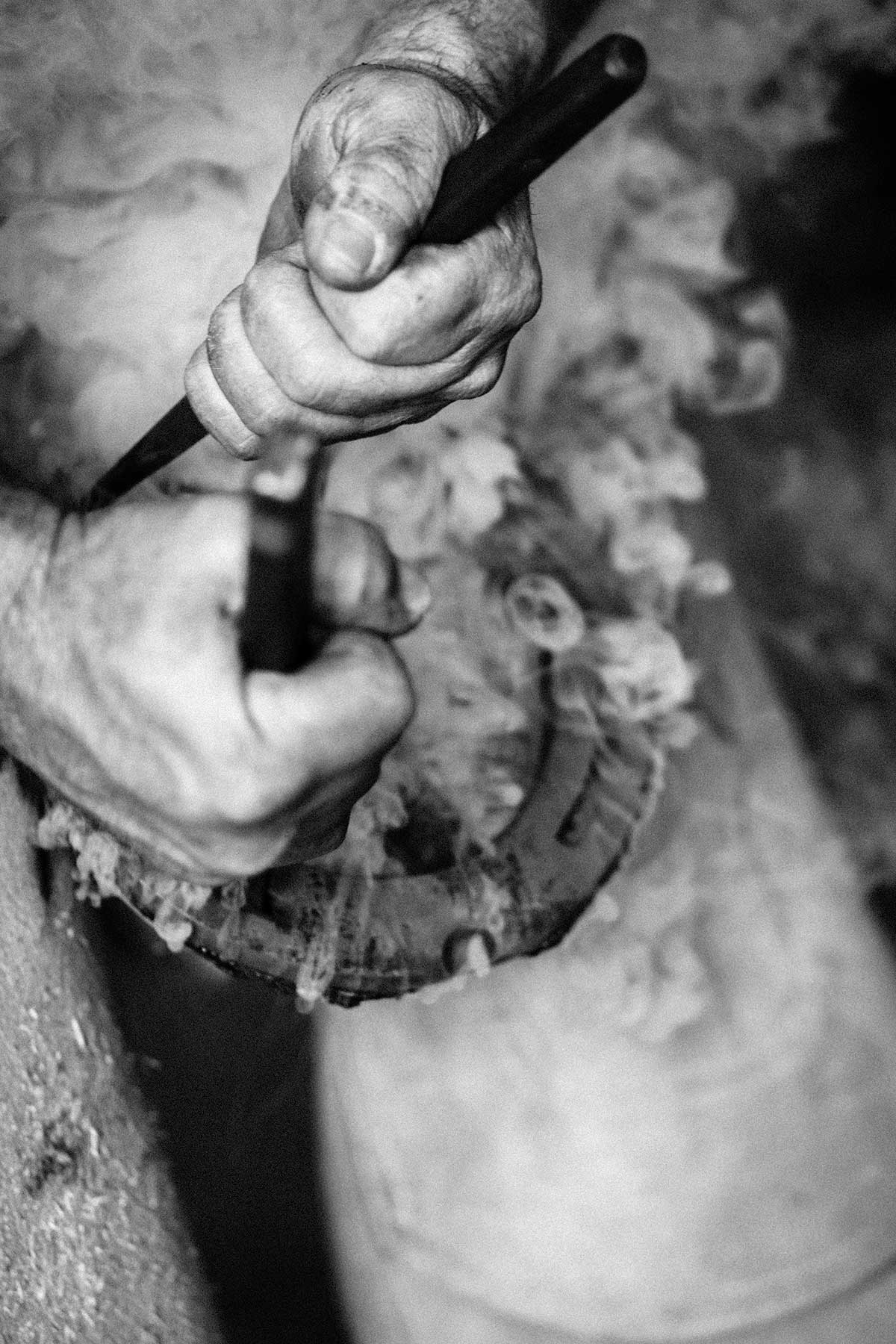
On an early morning, before the heat has settled in for the day, a gust of Oklahoma wind carries a familiar sound of hammer hitting steel out of a blacksmith’s workshop and across a pasture of grazing horses.
“He’s always practicing,” Dana Wetherell says when the noise starts back up. She’s talking about her longtime friend, neighbor, and farrier Mark Milster. In his professional career, Milster has managed to take a traditional approach to blacksmith and farrier work and use it to help modern Western performance horses compete at the highest levels of competition. His talents have taken him across the world to participate in and judge international farrier competitions and present shoeing clinics. In 2014, this lifelong dedication to furthering his craft led Milster to an induction into the International Horseshoeing Hall of Fame, located in the Kentucky Derby Museum in Louisville, Kentucky.
As Wetherell fetches her 18-hand, retired Clydesdale gelding, Drew, from the pasture to take over to the workshop, she shares a story about her farrier that’ll always stick with her. “I remember him telling me how he came close to winning at the World Championship Blacksmith Competition, but he could hear the clock ticking away while he was working,” Wetherell says. “The year he won his world championship he couldn’t hear anything going on around him—he was that focused.”
As we walk 50 yards down the road to Wetherell’s neighbor’s house, I ask why that story sticks with her so well, and she tells me that she likes to use Milster’s laser focus as inspiration when she’s showing her Quarter Horses at national-level competitions.
Getting His Start
When I first walk into Mark Milster’s shop, I’m greeted by his trusty four-legged sidekick, Crash. The newness of seeing me wears off, and Crash returns to his dog bed, which sits beneath a collection of dusty photos featuring an assortment of Western horses. When asked about the old pictures hanging on the wall in his workshop, Milster explains that they’re all customers of his from throughout the years.
I notice there are a few photos of himself from various blacksmith competitions, but he’d rather talk about the success of the different horses he’s worked on. After all, they’re the reason he does what he does.
The brick forge that sits in the middle of his shop begins to heat up, and Milster goes to work prepping Drew for his new set of front shoes. As he trims the large gelding’s left front foot, I pick Milster’s brain on how he got his start in horseshoeing.
He grew up in Missouri around horses and helped his father shoe horses as a kid. Milster never had the chance to meet his grandfather, but he’s heard from family that he was a farrier, as well. “I never planned on becoming a farrier,” the third-generation horseshoer explains. “My dad pushed me to study shoeing, but I decided to go to East Central University in Ada, Oklahoma, to play football and get a degree in criminal justice instead.”
What changed his mind? “I remember watching this guy shoeing my brother Marty’s horses and asking myself, ‘Why am I not the one shoeing those horses?’ It was like a lightbulb turned on, and I knew that was exactly what I was supposed to do.”
There was no backup plan after that. Milster sold a pistol given to him as a graduation present and used that money to buy his first forge.
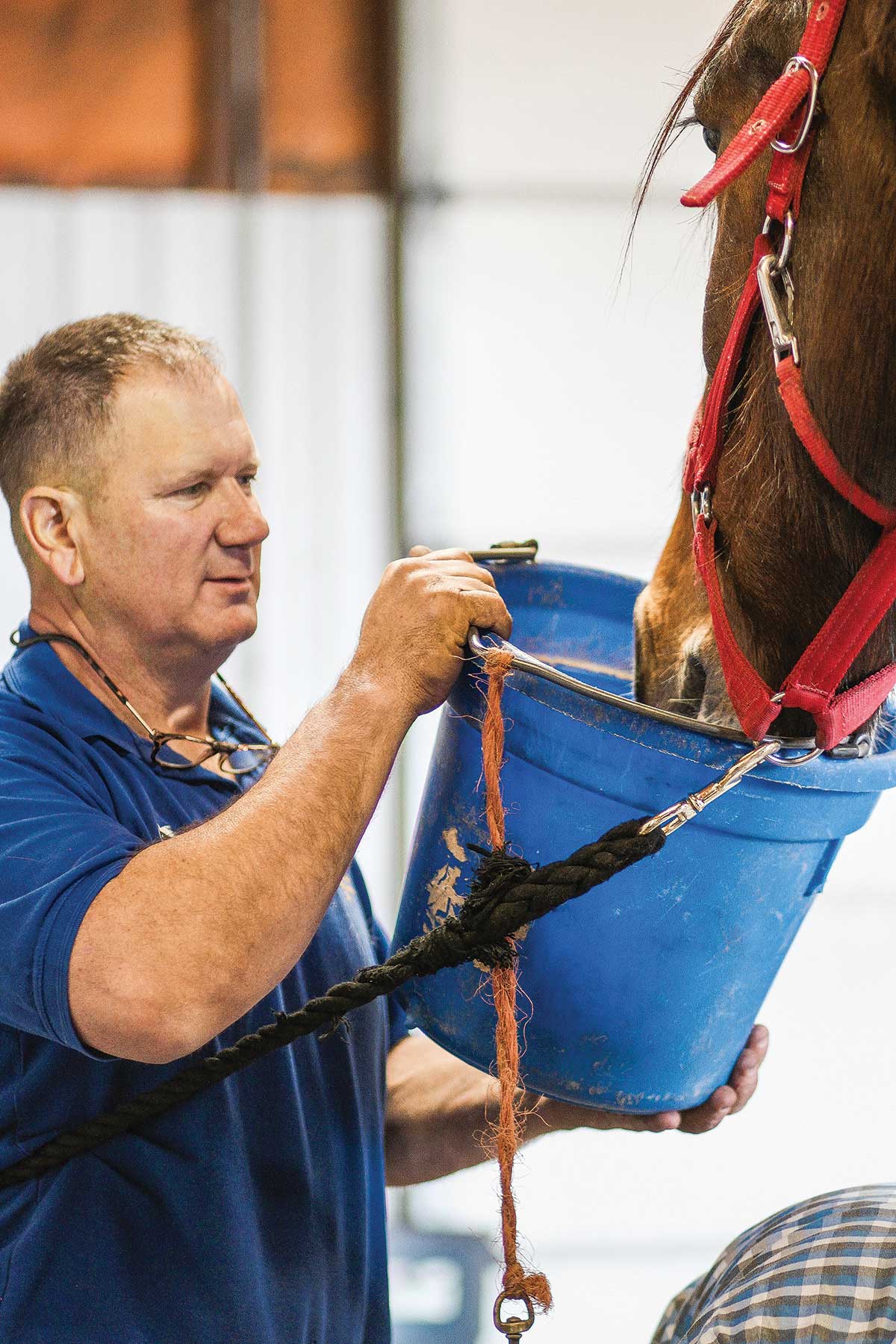
You’re Never Good, Unless You’re Ready
Milster briefly stops talking, puts down his hoof rasp, and walks over to give Drew a handful of grain. “Drew is one of my favorites,” he says.
He wipes his hands of excess feed and tells me that he originally regretted attending college and not going into shoeing right away. It wasn’t until he ran into his former professor, Norman Hess, at a local fairgrounds in Ada, Oklahoma, that he realized he made the right decision. “I started to tell Norman about regretting college, and before I could finish, he said, ‘You wouldn’t have been any good at shoeing horses,’” Milster shares with a laugh. “I turned to him and asked what he meant by that, and he said, ‘You’re never good at something, unless you’re ready.’”
Milster realized his former professor had a point. “I wasn’t ready to be a farrier at the time I started college. I think I would have a chip on my shoulder had I gone straight into it, and would probably lack the passion I have for it today.”
Milster studied at Oklahoma Farriers College—but only for two weeks. “My instructors said I was past what they could teach me, and that I’d be better off going out on my own and making a living.”
The World of Competition
I’m distracted by the number of tools I see around Milster’s shop, and ask how many he thinks he has. Rather than answering my question, Milster walks over to one of several toolboxes to pull open each drawer.
Every shelf is stacked to the rim with different tools. He picks up each piece and notes the person who crafted it quicker than I can write. He explains that they’ve all been created by good friends or mentors throughout the years—but a large part of his collection comes from pieces he’s handcrafted himself.
By now the brick forge is at the right temperature for Milster to begin custom-making Drew’s two front shoes. He grabs a pair of tongs and places the slab of steel into the forge. There are no shortcuts in Milster’s work. Each shoe is meticulously handcrafted to fit the needs of the particular horse he’s working with. “My only goal when I’m shoeing is to make the horse happy,” he says. “When the horse is happy, the owner is happy, the trainer is happy, and the veterinarian is happy.”
He’s often asked if there’s a difference in shoeing for customers versus shoeing for competition. To him, it’s all the same. “Anytime you shoe a horse you’re trying to please someone,” he explains. “In competition, you’re trying to please the judge; in a certification, you want to please the examiner; and in everyday shoeing, you need to please the horse and owner.”
That brings me to my next question: How did he get his start in blacksmith competition? He’s quick to credit friend and fellow farrier Sherrill Spears for introducing him to that world. Milster attended his first clinic with Spears at the American Farriers’ Convention in Little Rock, Arkansas, in 1991. That’s where he first witnessed a tryout for the American Farriers’ Team. “I was floored that something like this actually existed,” Milster says. “I couldn’t believe how talented these guys were, and I realized I had a lot left to learn. When I returned home I grabbed every horseshoeing book or magazine I could get my hands on.”
Milster once again picks up his tongs and pulls the steel from the forge, placing it on the anvil. His hammer hits the steel to shape the shoe, and the sound echoes through the workshop. Between clinks I ask him about his first shoeing competition.
Feeling inspired after watching the American Farriers’ Team, Milster hit the road again with Spears, traveling to Branson, Missouri. He grins when I ask how he fared at this competition. The contest required him to put keg shoes on a horse with a toe clip—something he hadn’t done before. “I walked away winning it,” he laughs. “The guys I was with were so mad.”
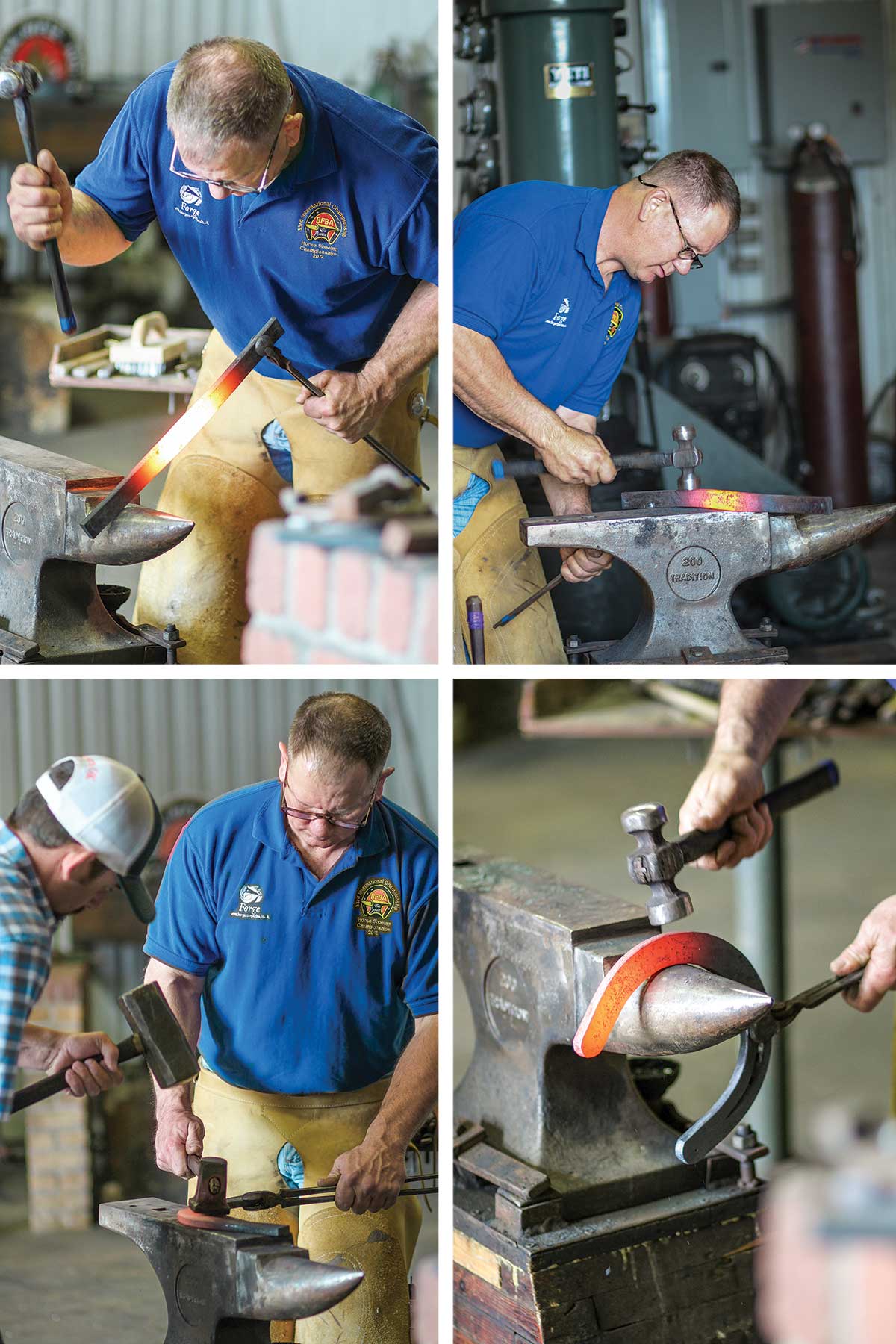
Learning How to Practice
Milster has since worked with a handful of farriers who’ve helped him master his craft, but one person in particular stands out: A legendary blacksmith and farrier from New Mexico named Jim Keith.
Keith’s name comes up often in our visit. Milster first read about him in a magazine. “I decided to drive to New Mexico to attend a five-day class he was teaching and paid $500 for that class,” Milster recalls. “I now go to his place as often as I can. But he hasn’t charged me since that first trip.” A small smile comes across his face when he mentions that last part.
When I tell Keith about Milster’s recollection, he laughs. “He’s an interesting guy to be around, and I enjoyed working with him, so I probably cut him a little slack with not charging him,” Keith jokes. “The first thing I remember about him was his attitude. He took instruction very well and accepted advice from anybody who’d give it to him.”
So what’s the most important thing Milster has learned from Keith? “How to practice,” Milster says without hesitation. “I saw what it took to be the best there is, and saw how much practice was involved to get to that level. There are people out there who have the will to win but don’t have the will to practice. Jim Keith is one of the few who has both the will to win and the will to practice.”
During his studies with Keith, Milster’s weeks consisted of shoeing horses in Oklahoma, and then driving to and from New Mexico on the weekends to study under Keith. Milster had set his sights on being part of the American Farriers’ Team, a team consisting of six American farriers chosen to represent the
United States in international forging competitions.
“I was a former manager for the American Farriers’ Team, and had some of the pins the team wears, so I sent Mark one,” Keith shares. “I told him that in five years he’d get to wear it. He was afraid I’d jinxed him, but sure enough, five years later he made the team.” Milster has now been part of the American Farriers’ Team five separate times.
Keith shares that some farriers work their whole lives to be part of the American Farriers’ Team, making selection for it an honor; accomplishing that kind of goal in such a short timeframe showcased Milster’s dedication to his craft.
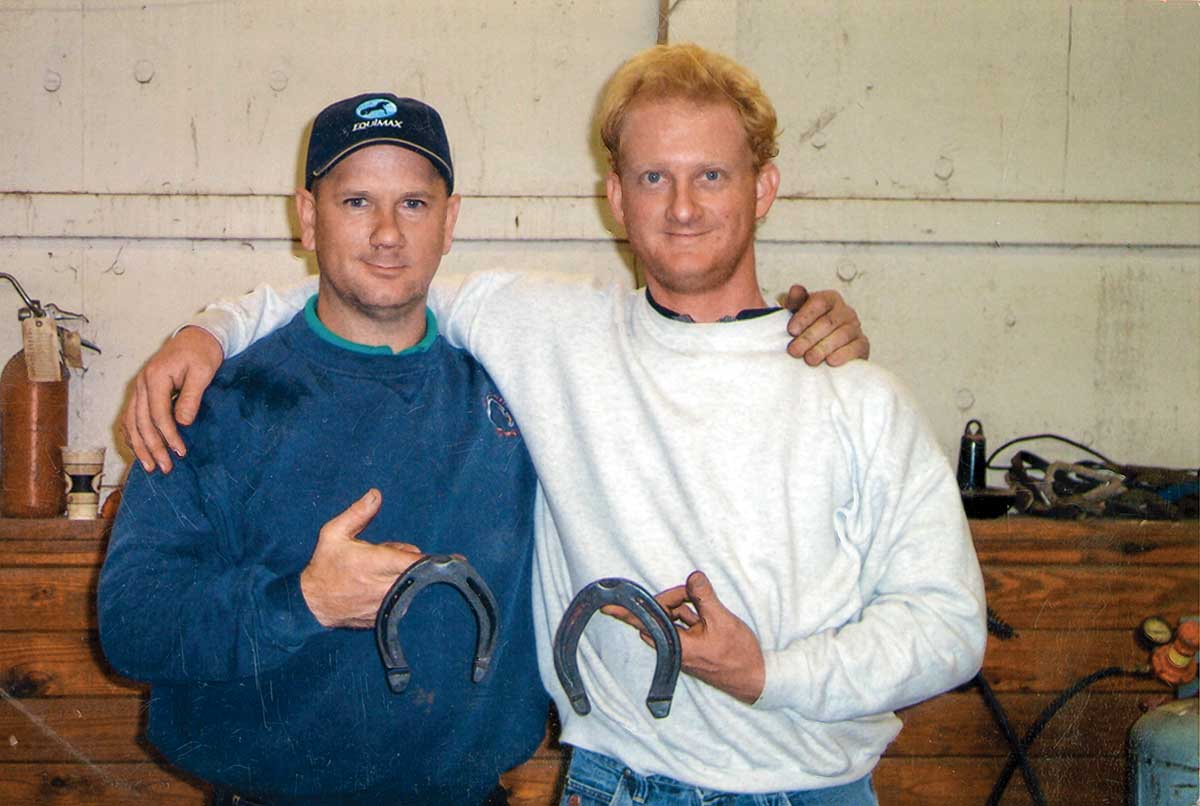
Teaming Up
Back in his shop, Milster continues working on Drew. Because he’s such a large horse, Milster has brought in friend Kyle Noyce to be his striker (the person who wields the sledgehammer), a common practice farriers use when working with larger, heavier shoes.
Milster and Noyce work as a team to create what I think is a perfectly constructed horseshoe. (Although, if you ask Milster, he’ll tell you the perfect shoe has yet to exist.) As I watch them work, I realize there’s an art to making a shoe that many don’t realize. Every move Milster and Noyce make together has a unique purpose that’s designed to help the horse they’re working with—and they make the whole process look almost effortless.
Milster is no stranger to working as a team. He’s won countless competitions where he’s been part of two-man and four-man crews. His most memorable win in a four-man team comes from the World Horseshoeing Classic held in Richmond, Kentucky, an international competition that takes place over the span of three days. On the first day the team makes draft shoes, the second day is fox-hunter shoes, and the final day is roadster shoes.
“Every shoe in that competition is handmade; it’s probably the highest standard of shoeing in any competition I’ve ever seen,” Milster says. “We won that competition in 2014 and 2015.” Back-to-back championships; an even more impressive feat.
However, when Milster pairs up with close friend Austin Edens—also a world-champion farrier—they’re a force to be reckoned with. Together they’ve won the two-man division at the annual Calgary Stampede five times. Milster doesn’t tell me much more than that, but MacKenzie Lawson, Milster’s apprentice, shares with me that when it comes to competition, the two of them have set the standard. “I think everyone secretly dreads when those two walk into a competition together,” she jokes.
Edens thinks that one of the reasons he and Milster click so well is they share the same passion for horseshoeing. “We’re both super competitive, and I think our competiveness with each other helps us both succeed,” Edens tells me. “The thing about Mark that makes him so different from other farriers is that he doesn’t get burned out. He’s always looking for the next big thing that’s going to help a horse.”
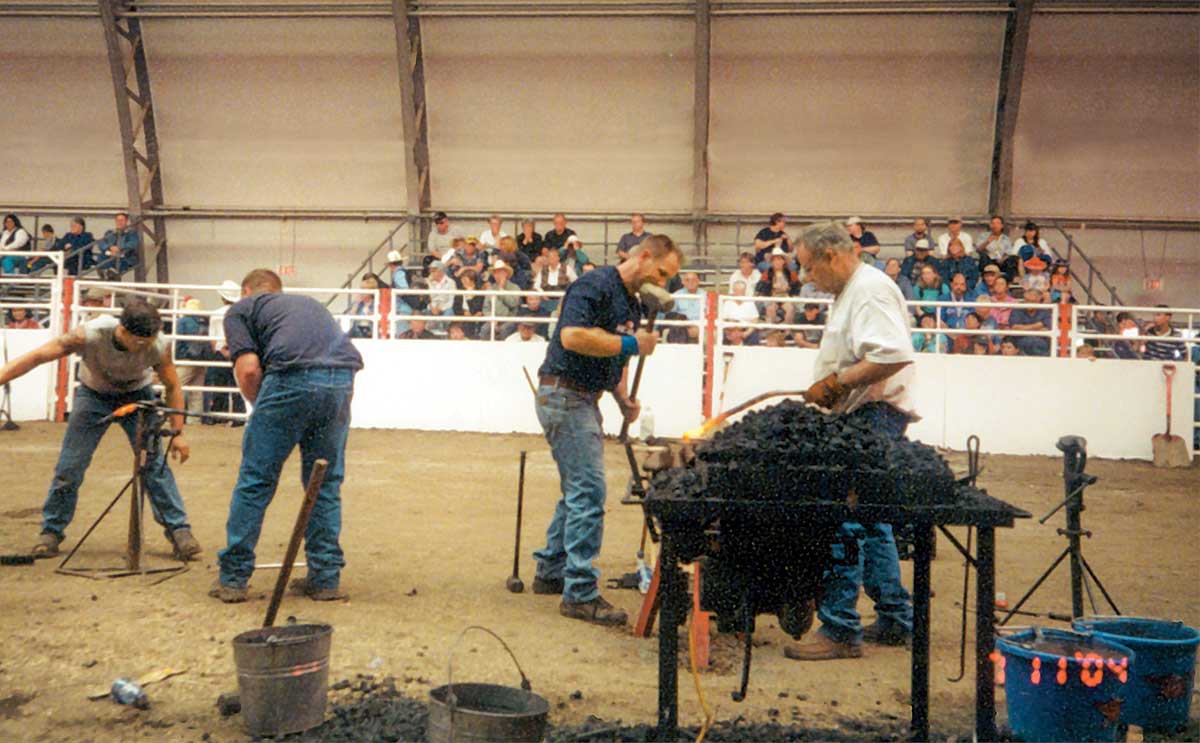
Winning the World
Milster finds a stopping point with the horseshoe he’s working on for Drew and walks into the small apartment that’s attached to his shop. He returns holding an old hammer. “This is the hammer I won my world championship with,” he explains. “The last nail is actually still in it.” I look closely, and sure enough I see a little nail wedged in there. He’s kind enough to bring it outside so I can photograph it, but I let him arrange it for fear of knocking that nail loose.
One of the highest honors a blacksmith can take home is winning the Blacksmiths’ World Championship at the annual Calgary Stampede. While Milster had come close to winning this individual world title two other times (by a half of a point, to be exact), it was in 2001 that he finally secured the title and brought the world-championship buckle home to Oklahoma.
Edens tells me that the year Milster won his world championship everything fell into place perfectly. “He finished with plenty of time left on the clock, and walked to the front of his horse and kissed the horse on the face,” he recalls. “Mark won’t ever say this out loud, but you could tell by his body language that he knew he’d won.”
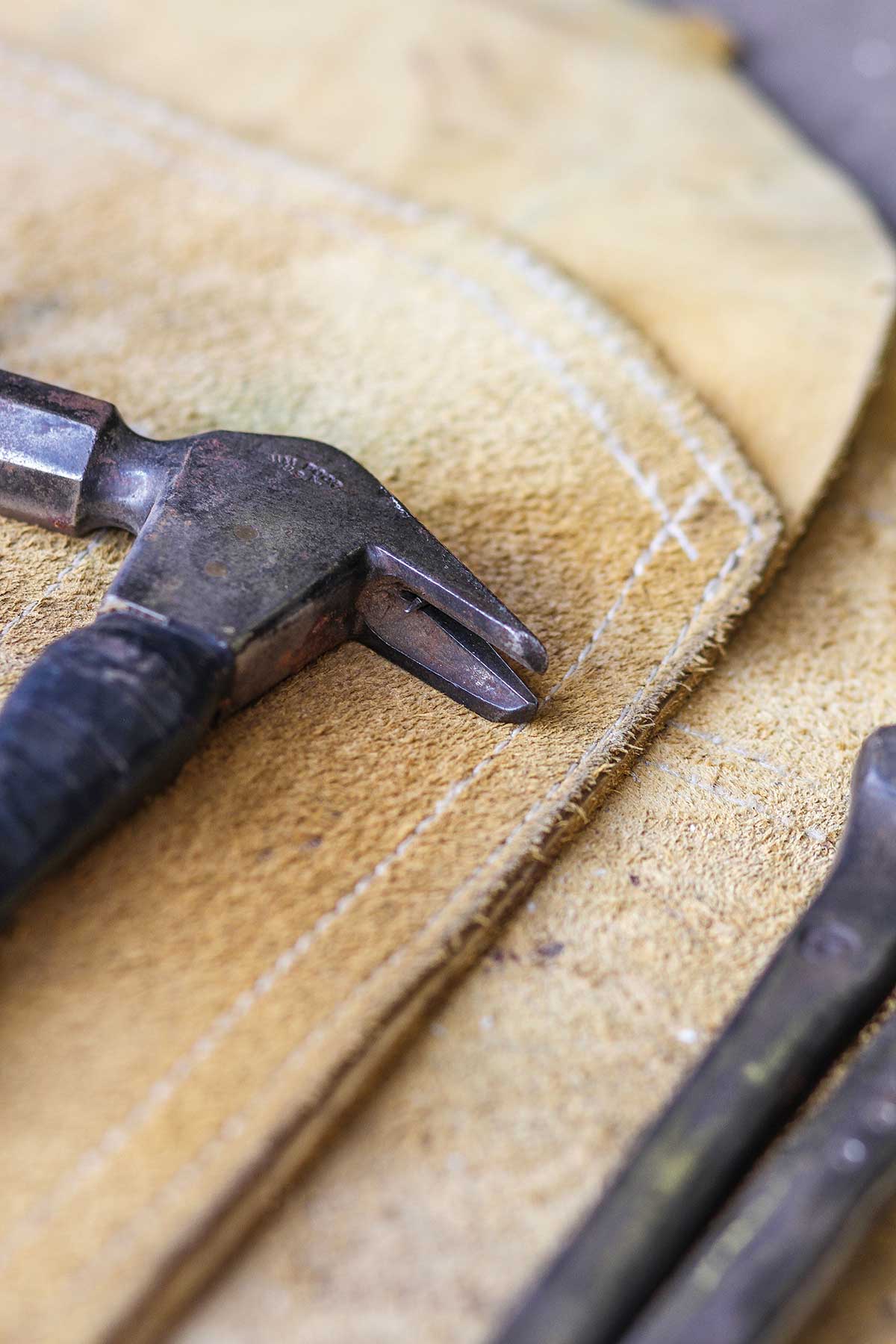
Striving for Perfection
By now, Milster and Noyce are back to work. I take a minute to photograph the sparks flying off the shoe as the sledgehammer hits the steel. The clinks stop, and Milster closely examines the shoe, deciding that it’s ready for Drew. They’re going to hot-shoe him, so back to the forge the shoe goes to heat up again. It’s a technique that’s been around for years, but it’s the first time I’ve seen it done in person.
Once the shoe is at the correct temperature, Milster and Noyce make their way over to Drew. As they press the shoe onto the Clydesdale’s gigantic hoof, smoke rises to the ceiling, and a distinct smell fills the air. I look over at Drew who doesn’t even notice that two men are working on his foot. In fact, the only thing he’s worried about is the treat his owner (and Milster’s neighbor), Dana Wetherell, has in her hand.
It’s another 15 minutes or so before the left shoe is finally finished, and the process starts from square one again as Milster and Noyce begin to shoe the other front foot.
Some more time passes, and the two farriers have successfully finished both front shoes. This time, instead of a handful grain, Milster finds a bucket and pours some more of the feed into it. He holds the bucket up to Drew, who willingly accepts his offer.
I pull out my camera to take a couple more photos of the end result, and out of the corner of my eye I see Milster studying each of Drew’s handcrafted shoes. “Here, take a picture of this shoe,” he gestures at Drew’s left foot. “It’s the better one.”
This is the essence of what makes Mark Milster the blacksmith and farrier he is: He’s always finding ways to improve on his own work. The constant challenge of creating the perfect shoe for a particular horse will keep him going for years.

